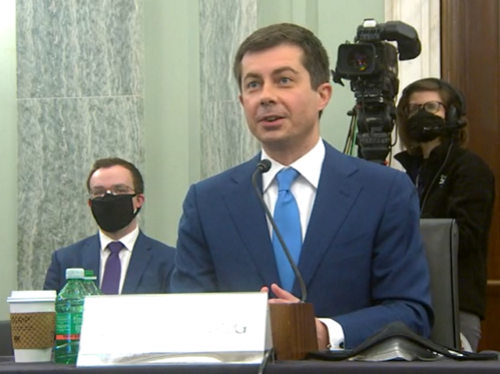Pete Buttigieg – former 2020 Democratic candidate for president and mayor of South Bend, Indiana – highlighted the importance of climate policy and active transportation needs within the Biden-Harris administration’s infrastructure investment plan during his confirmation hearing before the Senate Committee on Commerce, Science, and Transportation on January 21 to be the 19th U.S. Secretary of Transportation.
“Safety is the foundation of the department [of transportation’s] mission, and it takes on new meaning amid this [COVID-19] pandemic,” Buttigieg said in his written testimony. “We must ensure all of our transportation systems – from aviation to public transit, to our railways, roads, ports, waterways, and pipelines – are managed safely during this critical period, as we work to defeat the virus.”
Nominated to be USDOT secretary by President Biden in December 2020, Buttigieg also stressed that investment in transportation infrastructure will play a critical role in both restoring and growing the U.S. economy.
“We need to build our economy back, better than ever, and the Department of Transportation can play a central role in this by … creating millions of good-paying jobs, revitalizing communities that have been left behind, enabling American small businesses, workers, families and farmers to compete and win in the global economy, and tackling the climate crisis,” Buttigieg said.
“Infrastructure can be the cornerstone to all of this, and you have my commitment that I will work closely with you to deliver the innovation and growth that America needs in this area,” he emphasized.
Yet Buttigieg stressed during the question and answer portion of the hearing that, “ultimately, we cannot afford not to act on climate. The question becomes: How can we do that in a way that creates economic benefit in the near term, as well as preventing catastrophe in the long term?”
Buttigieg also stressed the need to expand the nation’s “mobility vision” when it comes to supporting active transportation efforts.
“There are so many ways that people get around,” he explained. “Often we’ve had an auto-centric view that has forgotten historically about all the other different modes. We want to make sure anytime we’re doing a street design that it enables cars, bicycles, pedestrians, businesses and any other mode to coexist in a positive way.” Buttigieg also emphasized that the United States has “historic opportunity here, on both sides of the aisle and with the public, for transportation investment – whether we are talking about trains, planes, and automobiles or next-generation transportation.”

